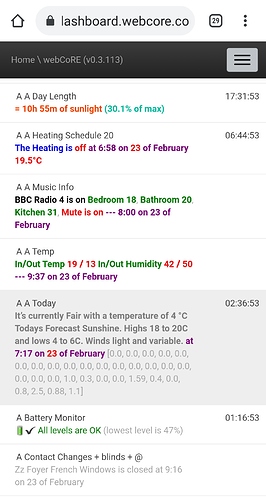Without official confirmation, the end of our webCoRE was indirectly confirmed by a Samsung employee a few days ago, something I’ve been dreading for 2 years now, as webCoRE is the most important part of my smart home.
First let’s go back to 2019 and the Samsung Developer Conference, the father of webCoRE (@ady624) made a great presentation showing webCoRE running locally on the hub, using RULES API. Great, fantastic, he signed into another local instance of webCoRE and showed he could make some pistons, all running locally.
At the time, Samsung was saying how they recognised how important webCoRE was to the community, and how they would be rebuilding webCoRE to work with the new API.
The presentation was entitled “Conquer IoT Automation with a Rebuilt webCoRE”, and as ST poached Ady to work for Samsung (specifically for how amazing his work on CoRE and webCoRE was) I thought webCoRE was in good hands. In the presentation, there were no variables yet or anything complicated, but in 18 months/2 years, if Ady was working on it, they should all be possible by now, unless Samsung have had Ady working on other parts of the platform, in which case he has been taken away from the community just to work for Samsung.
Here’s my question to Ady a few days ago on an ST forum thread about the new firmware…
Hi @ady624, I’m hoping you’ll be able to answer a question I’ve been waiting 18 months to ask you actually. Many of us avid WebCoRE users earnestly watched your impressive Samsung Developer Conference 2019 presentation of WebCoRE harnessing the Rules API and running locally on the hub, in a very fast and lightweight manner. At the time, you said “soon” it would become available, as 18 months have passed now, are you in a position to say when WebCoRE will be able to run locally (even without variables if necessary)? Because as an average user of moderate intelligence there’s no way I’ll be intellectually equipped enough to use the CLI, Postman or write JSON files, it’ll never happen, so a local WebCoRE with Rules API is what many of us are waiting, hoping, praying for… 

Strangely, Ady didn’t respond, even though he was active before on the thread, I posted right after him, then radio silence, which is ominous in itself. 24 hours later another Samsung employee posted, one that regularly doesn’t shy away from answering difficult questions as best they can.
“”"""
who is going to take on the job of turning webCoRE into a rule generator instead of a SmartApp generator
We are creating a web-based, rule building GUI that allows similar functionality to WebCore but based on Rule API. I’m not going to go into more details at this time since it’s still a PoC and needs additional development work, but it exists.
The functionality in the rule builder and near-term roadmap for the Rule API are based on an extensive metadata analysis of active WebCore pistons, an analysis of the core functional needs of the most popular SmartApps, and the feedback we’ve received from the community.
![]() blkwll:
blkwll:
> It sure would be swell to have, at least, WC to JSON conversion
This is also in the works and will be made available before anything happens to WebCore. There will likely be some manual work involved for users (i.e. post the converted JSON to Rule API using the rule builder) but it is planned to be minimal and straightforward.
“”"""
This doesn’t sound like the rebuilt webCoRE we were promised running locally on the new platform, this sounds like the end of webCoRE that we know and love. It sounds like they are just going to release a simple web gui that may look like webCoRE in appearance, but that will turn simple pistons into rules and convert them into automations where they will live as one off pieces of code. And when they turn off groovy this year, webCoRE will be gone.
Whats particularly worrying, and VERY bad news is this part… “The functionality in the rule builder and near-term roadmap for the Rule API are based on an extensive metadata analysis of active WebCore pistons, an analysis of the core functional needs of the most popular SmartApps, and the feedback we’ve received from the community.”
So no more piston states, no more sharing of pistons, copying other peoples complex pistons, no http requests, no communicating between hubs and sending variables back and forth, no nothing, we will probably be left with a simple rule builder that does 30% of what webCoRE can do today, 30% at best. No sending of photos dynamically from a Raspberry Pi to an ActionTiles tablet.
No rules like at sunset wait randomly between 1 and 30 minutes and if wind speed is less than X then open an awning but IF a certain motion sensor is active, then wait until a different motion sensor is active then open the awning, but if wind speed rises above X during the night then close the awning.
So if anyone is still waiting for some clarity or honesty from ST/Samsung about the end of life of webCoRE it’s not going to happen. So either the community somehow get together to try to save and reprogram webCoRE for the new RULES API or if we leave it to Samsung, when they turn off groovy THIS year (2021), the webCoRE that we know and love on the ST platform, will be gone forever.


